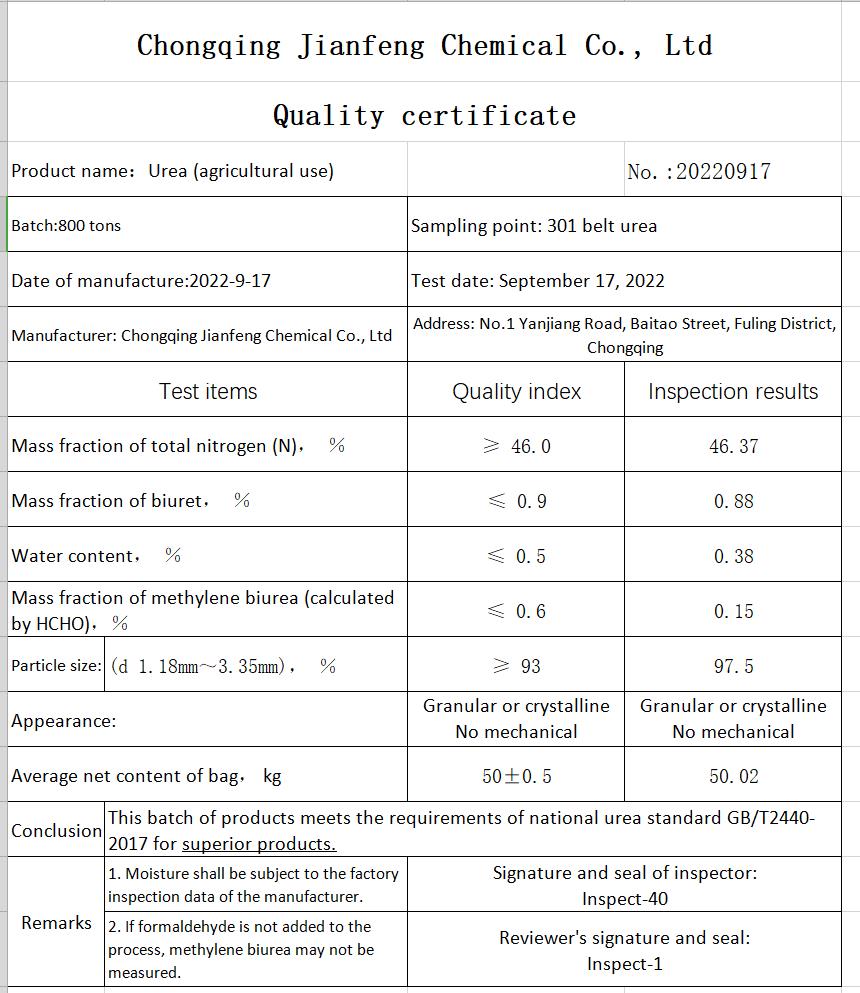Urea, also known as urea or carbamide, is an end product of protein metabolism in humans and mammals, as well as a major organic nitrogen compound excreted by animals. The pure product is white granular or acicular or prismatic crystal, and it is light red or yellow when mixed with iron and other heavy metals. It is tasteless and odorless, soluble in water, ethanol and benzene, and insoluble in ether and chloroform. At 20 ℃, 100 kg of water can dissolve 105 kg of urea, which absorbs heat. The aqueous solution is neutral. The nitrogen content of the pure product is 46.65%, the agricultural urea is 42%~46%, and it contains a small amount of biuret, generally less than 2%, which is generally harmless to crop growth; The specific gravity and unit weight of urea are small, and the weight of fertilizer per cubic meter is 0.65 tons. Urea is an important nitrogen fertilizer with high quality and efficiency. At the end of World War I, Germany began to use urea as fertilizer. Practice has proved that urea has a high nitrogen content and no side components, which shows a good yield increase effect on all crops. Since the 1950s, it has become a key nitrogen fertilizer variety developed by various countries. In the 15 years from 1960 to 1975, the global urea output has increased by 10.5 times, and it has gradually replaced ammonium nitrate since the 1970s, becoming the most widely used nitrogen fertilizer variety in the world. After urea is applied to the soil, a small part of it is absorbed by the plant in the form of amide, and most of it is ammoniated under the action of urease, converted into ammonia, and then absorbed by the plant. The decomposition rate depends on the soil quality, chemobook temperature and water content, generally in 3 to 10 days. Therefore, the fertilizer effect of urea is longer than other nitrogen fertilizers, and the nitrogen loss is less. Urea is an ideal fertilizer for topdressing outside the root, because it does not contain harmful ingredients to crops, is neutral, does not burn the stems and leaves, has strong moisture absorption, and is easy to penetrate into the leaves with water and be quickly absorbed by crops. The concentration of topdressing outside the root is generally 0.5%~2%. In order to improve the effect of urea utilization, in addition to correctly mastering the properties and application conditions of urea, attention should be paid to rational application. Urea is a neutral fertilizer and contains no harmful components. Hydrolysate NH+4 and HCO-3 can be absorbed and utilized by crops. It is applied year after year, and generally has no adverse effect on soil properties. It is applicable to all kinds of crops and soils, and its fertilizer efficiency is similar to that of ammonium sulfate with equal nitrogen content; The effect is better than that of ammonium sulfate when it is used in the "aged" paddy field which lacks active iron and is prone to hydrogen sulfide poisoning. Too much urea or too high biuret content will easily cause ammonia and biuret toxicity to crops; The higher the urease activity of crops, the more sensitive to the toxicity of urea and biuret. Urea can be used as a supplementary feed for anti nestling animals. In industry, urea is the raw material for the synthesis of urea formaldehyde, melamine formaldehyde resin, etc. Medically, it is used to manufacture tetracycline, phenobarbital, caffeine and other drugs. The dye industry uses it to produce vat brown BR, phthalocyanine blue B, etc. Urea is packed with plastic film inside and woven bag outside. It shall be stored in a dry warehouse and shall not be stored and transported together with acids.

